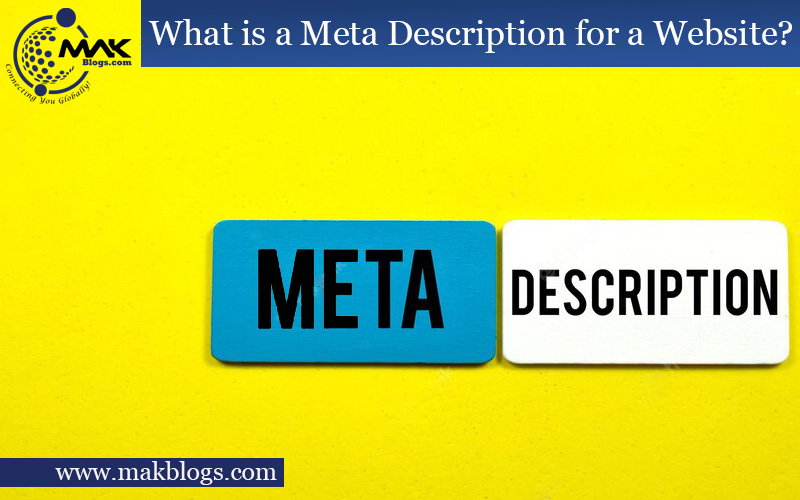Table of Contents
ToggleQuick Overview of “What is a Meta Description for a Website?”
This comprehensive guide has explored “what is a meta description for a website” and its critical role in SEO and user engagement. A meta description is a concise HTML attribute that appears below the page title and URL on search engine result pages (SERPs). Users are encouraged to click the link and visit the webpage by this preview sample. Crafting an effective meta description involves, optimizing it for mobile viewing, utilizing rich snippets to provide additional information, incorporating relevant keywords without overstuffing.
By following best practices and avoiding common pitfalls like duplicate descriptions, web admins can enhance their website’s click-through rate, drive organic traffic, and create a positive user experience. Embracing the potential of well-crafted meta descriptions can significantly improve a website’s performance and visibility in the competitive digital landscape.
What is a meta Description for a Website?
Introduction
In the digital landscape, where websites compete fiercely for attention, the need to stand out and captivate visitors is paramount. And that’s where Search Engine Optimization (SEO) steps in as the guiding force that drives organic traffic to websites. One crucial aspect of SEO that holds the power to attract curious eyes and intrigued clicks is the art of crafting a captivating meta description for each web page. In this all-encompassing guide, we will delve into the fascinating world of meta descriptions, demystify their significance, and unravel the secrets behind creating SEO-friendly and engaging meta descriptions for websites.
So let’s start this educational adventure to learn more about a website’s meta description and how it may improve your internet presence.
Understanding Meta Description

A meta description is a condensed HTML property summarising a web page’s content. On search engine result pages (SERPs), a preview snippet is shown beneath the page title and URL. Meta descriptions encourage readers to follow the link and visit the page.
Example: Imagine this scenario, you are searching for information on “what is a meta description for a website” on your favourite search engine. Among the search results, you come across a link that stands out with a concise and enticing meta description. It reads, “Unlock the power of meta descriptions for your website – Learn how to craft compelling summaries that attract visitors and boost your search rankings!”
In this example, the meta description serves as a teaser, offering a glimpse into what the webpage holds in store. It immediately captures your attention and sparks curiosity, prompting you to click the link to satisfy your quest for knowledge. This is the magic of a well-crafted meta description – it acts as the gateway to your website, inviting users to explore your valuable content further.
The Significance of Meta Descriptions for SEO

In the context of “What is a meta description for a website?” An effective meta-description can significantly impact a website’s organic search performance. Some of its key benefits include:
- Higher Click-through Rate (CTR): A well-crafted meta description is a persuasive invitation to users, encouraging them to click on your link instead of others on the search results page. By offering a clear and enticing preview of what your webpage offers, you can attract more clicks and increase your CTR.
Example: Suppose you run an e-commerce website selling handcrafted jewellery. A meta description like, “Discover stunning artisan jewellery – Handmade with love and unique designs. Shop now and elevate your style!” will entice users to explore your exquisite collection.
- Improved User Engagement: When users find a meta description that aligns perfectly with their search intent, they are likelier to stay on your website longer. This increased dwell time signals search engines that your content is relevant and valuable, positively impacting your SEO efforts.
Example: For a blog post about “Healthy Breakfast Ideas,” a well-optimized meta description such as, “Start your day with a burst of energy – Explore our nutritious and delicious breakfast recipes for a healthy lifestyle!” will engage health-conscious users seeking breakfast inspiration.
- Reduced Bounce Rates: A relevant meta description ensures that visitors find precisely what they are looking for, reducing the likelihood of returning to the search results page immediately. This signals search engines that your webpage provides valuable content, contributing to improved rankings.
Example: In the realm of “What is a meta description for a website?” If your website offers, online coding tutorials and your meta description reads, “Master coding from scratch – Step-by-step lessons for beginners and experienced programmers,” users interested in coding will likely stay on your site, reducing bounce rates.
- Keyword Relevance: Including the target keyword in the meta description reinforces its relevance to the search query. This attracts users’ attention and helps search engines understand the context of your content.
Example: For a website providing tips on “What is a Meta Description for a Website,” an optimized meta description like “Learn all about meta descriptions – The ultimate guide to crafting SEO-friendly summaries for webpages” emphasizes the keyword’s importance.
- Brand Visibility: In the context of “What is a meta description for a website?” Crafting unique and compelling meta descriptions enhances brand recognition. Searchers are more likely to trust your site if they see it often.
Example: A well-established technology blog can leverage its brand reputation with a meta description like, “Stay updated with the latest tech trends – Expert insights and in-depth reviews on our leading tech blog.”

- Call-to-Action (CTA): A strategically placed call-to-action in the meta description encourages users to take specific actions, such as exploring products, signing up for a newsletter, or reading an article.
Example: In the case of a website advertising financial planning services, a compelling call to action (CTA) could read: “Secure your financial future – Schedule a free consultation now and take the first step towards financial success!”
- Mobile Optimization: Regarding “What is a meta description for a website?” Mobile-friendly meta descriptions are vital for attracting smartphone and tablet users as mobile usage continues to soar. A concise and captivating meta description is essential for smaller screens.
Example: A travel website can optimize for mobile with a meta description like, “Your dream vacation awaits – Discover the best destinations and book your adventure on the go!”
- Social Media Shares: A compelling meta description can be the default snippet when users share your content on social media platforms. Engaging meta descriptions can drive more clicks when shared by users.
Example: If your website hosts a collection of mouthwatering dessert recipes, a shareable meta description such as, “Indulge in sweetness – Delectable dessert recipes for every occasion!” encourages users to share the link with their friends.
- Snippet Customization: In the realm of “What is a meta description for a website?” While search engines generate meta descriptions automatically if they are missing, crafting your own allows you to control the content that appears in search results, maximizing the chances of attracting clicks.
Example: Suppose you own a fitness blog. By writing a meta description like, “Achieve your fitness goals with expert guidance – Workout routines, nutrition tips, and more!” you ensure that the relevant information appears in search results.
- Competitive Advantage: In a crowded online landscape, a captivating meta description sets you apart from competitors and entices users to choose your website over others in search results.
Example: If you operate an online bookstore, a well-optimized meta description such as, “Explore a world of books – Bestsellers, classics, and rare finds all in one place!” can give you a competitive edge in attracting book lovers.
Crafting an SEO-Friendly Meta Description

In the context of “What is a meta description for a website?” Creating a well-optimized meta-description requires creativity, relevance, and adherence to certain guidelines. Here are some essential tips to craft an SEO-friendly meta description:
- Be Concise and Specific: Aim for a meta description between 50 to 160 characters to ensure it appears in its entirety on SERPs. Be specific about the page’s content to attract the right audience.
- Use Target Keywords: To attract search engines and users, organically include the page’s main keyword in the meta description.
- Example: For a blog post about “The Benefits of Yoga,” a suitable meta description could be: “Discover the numerous health benefits of yoga – from stress relief to improved flexibility – in our comprehensive guide.”
Optimizing Meta Descriptions for Clicks

Regarding “What is a meta description for a website?” Consider these methods to get users to click your link:
- Call to Action (CTA): Include a compelling CTA to prompt users to take action, such as “Read more,” “Explore now,” or “Discover the secrets.”
Example: “Revamp your website today – Explore our services and unlock the potential of captivating meta descriptions!”
- Be Concise and Specific: Keep your meta description within the recommended character limit (usually 50-160 characters) to ensure it appears fully on SERPs. Use language that communicates the value users will find on your webpage.
Example: “Discover top-notch web design tips – Elevate your website’s appeal with our expert advice!”
- Address User Intent: In the realm of “What is a meta description for a website?” Address the search query’s intent in your meta description. This ensures users feel your page will provide the answers or solutions they seek.
Example: “What is a Meta Description for a Website – Your ultimate guide to mastering this SEO essential and driving more traffic!”
- Add a Sense of Urgency: Use terms that make users click your link immediately.
Example: “Limited time offer – Grab your free e-book on crafting perfect meta descriptions now!”

- Use Power Words: Utilize strong and emotive words that evoke curiosity, excitement, or intrigue, encouraging users to explore your content.
Example: “Unleash the potential of your website – Supercharge SEO with our meta description techniques!”
- Address the Target Audience: In the context of “What is a meta description for a website?” Tailor your meta description to resonate with your target audience, addressing their needs and preferences.
Example: “For bloggers and content creators – Learn how to write meta descriptions that boost your online visibility!”
- Include Numbers and Stats: If relevant, incorporate numbers or statistics in your meta description to make it more compelling and credible.
Example: “Increase CTR by 30% – The impact of well-optimized meta descriptions on website traffic.”
- Use Emotional Appeal: Appeal to users’ emotions by conveying the benefits they will gain from visiting your website.
Example: “Ignite your creativity – Explore our collection of inspiring design resources!”
- Localize if Applicable: Regarding “What is a meta description for a website?” If your webpage targets a specific location, include relevant location-based keywords to attract local users.
Example: “Find the best restaurants in NYC – Savor the culinary delights of the Big Apple!”
Avoiding Common Mistakes

To ensure your meta descriptions are effective, avoid these common pitfalls:
- Duplicate Descriptions: Each page must have a unique meta description to avoid confusion and improve relevancy.
- Keyword Stuffing: Although using the target keyword is essential, overstuffing the meta description with keywords can make it appear spammy.
- Irrelevant Descriptions: Make sure your meta descriptions are directly related to the page’s content. Irrelevant descriptions can mislead users and lead to higher bounce rates.
- Excessive Length: In the realm of “What is a meta description for a website?” Keep your meta descriptions concise and within the recommended character limit. Lengthy descriptions may get cut off in search results, leading to incomplete information.
- Missing Meta Descriptions: Every page should have a meta description. Leaving it blank can result in search engines automatically generating one that may not accurately represent your content.
- Omitting the Target Keyword: While keyword stuffing is not recommended, omitting the target keyword entirely can lead to missed SEO opportunities.
- Using Non-Descriptive Language: Avoid vague or generic language that fails to convey the unique value of your webpage.
- Lack of Call-to-Action: Please include a call-to-action to avoid users taking any specific action after reading the meta description.
- Ignoring Branding Opportunities: Incorporate your brand name or unique selling proposition (USP) into the meta description to enhance brand recognition.
- Neglecting Updates for New Content: Revise and optimize the meta descriptions when updating your website with fresh content.
Best Practices for Meta Description

To optimize meta descriptions further, follow these best practices:
- Mobile-Friendly Descriptions: Meta descriptions should be written with mobile users in mind as their numbers grow.
- Utilize Rich Snippets: Implement structured data to enhance your meta description with additional information, such as star ratings, product prices, or event dates.
Google Reference
Regarding “What is a meta description for a website?” Enhance Your Website’s Search Appearance with Google’s Developer Documentation on Search Snippets – Learn how to craft compelling meta descriptions and utilize structured data to boost your website’s SEO performance and attract more clicks!
https://developers.google.com/search/docs/appearance/snippet
Conclusion
Regarding “What is a meta description for a website?” It is a vital SEO element that holds the power to drive organic traffic and engage users effectively. Web managers can employ best practices, mobile optimization, and rich snippets to write attractive meta descriptions that persuade people to click and explore their important content. Avoiding duplicate descriptions and keyword stuffing keeps meta descriptions relevant to search engines and users. Embrace the potential of well-crafted meta descriptions to boost your website’s performance and leave a lasting impression on users in the competitive digital landscape.
FAQs related to “What is a Meta Description for a Website?”
: It includes:
“Discover top-notch web design tips – Elevate your website’s appeal with our expert advice!”
“Unlock the secrets of successful digital marketing – Enroll in our online course today!”
“Explore the latest tech gadgets – Stay ahead with our unbiased reviews and recommendations!”
“Delight your taste buds – Find the best restaurants in NYC for a culinary adventure!”
“Transform your fitness journey – Join our fitness community and achieve your goals!”
Read more in the above post titled “What is a meta description for a website.”
It is a tool or software that automatically creates meta descriptions for web pages. It analyzes the page’s content and generates concise and relevant summaries to be displayed on search engine result pages (SERPs). This helps web admins optimize their meta descriptions for better SEO and user engagement without manual input. Read more in the above post titled “What is a meta description for a website.”
To write a meta description, keep it concise (around 50-160 characters), use the target keyword naturally, and provide a compelling summary of the webpage’s content. Address user intent, include a call-to-action, and highlight unique selling points. Avoid keyword stuffing, duplicate descriptions, and misleading language. Regularly review and update your meta descriptions for fresh content and improved SEO performance. Read more in the above post titled “What is a meta description for a website.”
The recommended length is typically between 50 to 160 characters, including spaces. Read more in the above post titled “What is a meta description for a website.”
Title tags, often known as meta titles, specify a web page’s title in HTML. The browser’s title bar and SERPs’ clickable headline display it. The meta title summarises the page’s content, helping users and search engines comprehend it. Read more in the above post titled “What is a meta description for a website.”
No, meta descriptions do not directly influence search engine rankings. However, they are crucial in driving user engagement and improving click-through rates. Read more in the above post titled “What is a meta description for a website.”









